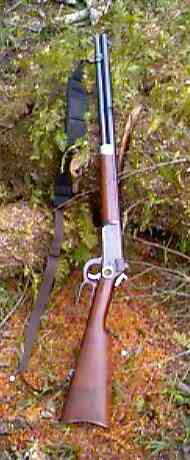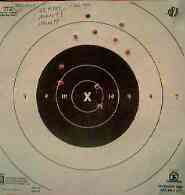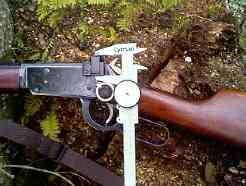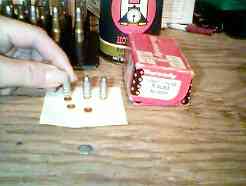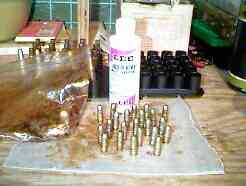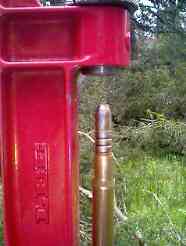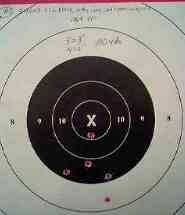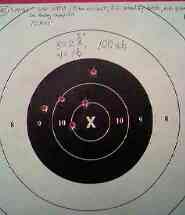Copyright 2003 by Junior Doughty
Heck, it's a good thing the guy at the gun show didn't want $300 for ol' Bill because I would have paid it. Bill looked new except for deep scratches in the fore end cap and a little bluing wear. I replaced the cap, and I think I added the silver saddle ring—memory fades after 20 years. I installed a Williams peep rear sight and an Uncle Mike's swivel set. To make the factory bead front sight work better for target shooting, I filed it flat on top. It's now an upside down semicircle .084" wide. Bill's short, 20" octagon barrel was stiff, and I saw in that short, stiff barrel the possibility of good accuracy. The installation of the peep sight increased Bill's sight radius from 16" to 23 1/4"—a 45% increase and another harbinger of good accuracy. I shot a few cast bullets through ol' Bill, enough to see a potential for 3" or so groups at 100 yards, and then I stuck him in a closet. In that and other closets he remained almost unfired for 20 years. Ol' Bill's only excitement came about 10 years ago when my son-in-law used him and killed a nice buck with an RCBS 180 gr FP bullet pushed with H4895. One shot, one deer. Then in March 2003, I decided I needed a cast bullet rifle with fast repeatability for hog hunting. A cast bullet in my 45-70 Handi-Rifle would drop any hog that ever lived, but if I missed, I wanted a fast follow-up shot. Wild hogs are dangerous game in my opinion. A vivid memory from my childhood is the very long hour a friend and I spent in a tree while an enraged wild sow tried to root the tree up, knock it down, chew it in two, and climb it. My friend had shot her in the butt with squirrel shot. (No, I never went hunting with him again.) I remember watching the hog chew the muzzle of the .410 bolt action shotgun I had dropped at the base of the tree. I wished for a string from the trigger to my finger.
Here's the data on the Lee C309-170-F bullet cast from wheel weights:
I sorted those bullets by 2 Standard Deviations which gave me bullets
The Lee sizing and liquid lube process was fast and easy. I dropped the as-cast bullets in a zip sandwich bag, squirted in some liquid Alox, kneaded the bag a few seconds, then removed the bullets and stood them on wax paper to dry. After about 20 minutes of drying, I placed a gas check on the base of the bullets and ran them nose first through the sizer. All sized, I threw ‘em back in the zip bag of lube, kneaded a little, then stood 'em on end again and let dry again. Took about as long to say it as to do it. I sized about 50 bullets with the Lyman and about 50 with the Lee. In cardboard storage boxes in the spare bedroom, I found 3 partial boxes of R-P cases fired an unknown number of times and fired in either Bill or in a less fortunate 30-30 rifle I sold in hard times. I discarded the ones spotted with 20 years of verdigris, and I then full-length re-sized and de-primed the rest. I then cleaned the primer pockets and trimmed them. I tumbled them in walnut media for 12 hours, making them bright and shiny. As a final case preparation step, I dropped them in an empty gallon milk jug, added a squirt of dishwashing liquid, then covered them with hot tap water and started shake shake shaking. The cases clean of walnut media dust, I rinsed them and let them dry overnight. The next morning I sorted them by 2 Standard Deviations. They averaged 128.09 grs and weighed between 126.5 and 129.7 grs. My 20 year old MTM Handloaders Log showed no mention of the Lee 170 FP for some damned reason. But for the 180 RCBS FP, it showed poor groups with Reloader 7 and BLC-2 and good 1800 fps, 100 yard, 3 3/8" to 4 3/4", 3 shot groups with H4895. So I decided to start my shooting with H4895, thinking I could perhaps reach 2000 fps muzzle velocities with the 170 gr Lee. As my shooting bench is maybe 20 feet from my loading bench, I could load 3 rounds and quickly shoot them, running them through my Chrony chronograph. My targets were NRA # B-8 25 yard pistol targets with the 5 1/2" bull and placed at exactly 100 yards. I quickly discovered 3 facts:
The smallest 3 shot group was 2 3/4" and the largest was 10 1/2". Extreme Spread varied from a low of 25 fps to a high of 177 fps. Each shot left unburned powder in the bore. Obviously, I was getting erratic ignition and/or poor burning. Bill was an equal rights rifle. He seemed to like neither Lyman sized bullets nor Lee sized bullets. Then it struck me: maybe Bill didn't like the velocity of those bullets. Or maybe he didn't like H4895. I decided to try lower velocity loads of H4198—and hit paydirt. I started getting 3" to 4" 3 shot groups with an average ES of around 50 fps. One 3 shot group measured a tiny 1 5/8" with an ES of only 26 fps. Bill liked H4198 and lower velocities. Below, see the results of 19 groups of 3, 5, and even 10 shots with H4198:
The smallest group was 3 shots in 1 5/8", and the largest was 3 shots in 5 1/4". Lowest ES was 18 fps and highest was 104 fps. I could detect no measurable difference between groups fired with the bullets sized .310" in the Lyman Sizer Lubricator and .309" in the Lee Sizer. Neck sizing the cases with a Lee Loader also gave no noticeable improvement in accuracy. A 20x scope might have made a difference. But not iron sights.
I selected 21.2 grs of H4198 because the combination of Lee dippers 1.3 cc + .5 cc = 21.2 grs H4198. I wanted to be able to load my hog-hunting rounds in my tent, i.e., Lee dippers instead of a fragile and hard-to-pack powder scale. Below, see the results of 5 groups of 5 shots, all shot while adjusting the sights. All 25 rounds were loaded with the 1.3 cc + .5 cc Lee dippers. Both Lee sized and Lyman sized bullets were used.
I pushed the base of an as-cast bullet into a gas check, then raised the bullet and gave it a shake. The gas check stayed in place. Then I wondered if the check would fit inside the mouth of a fired case. I tried it. It fit. The bullet sat atop the case with perhaps the bottom 1/3 of the gas check inside the case mouth. If the un-sized, un-belled neck would seat the gas check—and if Bill easily chambered the resulting loaded round—I could eliminate 3 steps:
The photo on the right shows me finger applying gas checks to bullet bases. I just pushed the bullet down into the check, and the check stayed in place on the bullet.
The lube partially dry and the consistency of thick molasses, I removed the bullets and stood them nose up on wax paper. Some 30 minutes later, they were ready for seating in cases. Some bullets in the photo look cocked to one side, but that's due to the uneven surface of the wax paper, not mis-installed gas checks.
Notice the gas check maybe half way inside the case mouth. I'm using a Lee Hand Press and a Lyman seating die. Each bullet traversed the length of each case neck with slight, even force. The beginning 1/8" required the most force as the gas checks fully entered the case mouths and seated or partially seated into the bullets. Note: The above seating method won't work with a hard bullet. The case neck isn't strong enough to force the gas check lip into the surface of the bullet. The un-seated gas check will swell the case neck, making it look like a snake that swallowed an egg. The loaded round won't chamber. Test case neck gas check seating with a reject bullet and case. The Lyman seating die was adjusted for the exact same crimp used for seating all previous bullets—medium heavy. I didn't want any round in Bill's magazine with a bullet pushed inside the case. The acid test came when I chambered in the rifle the rounds I had loaded in un-sized cases—all chambered easily. Then came group shooting. I shot 2 groups of 5 shots each. Below, see the results:
Supplies:
When aiming at the 5 1/2" bull, I placed the bull directly on top of the rifle's flat front sight. My zero point, then, was about 1 1/2" up from the bottom of the bull.
Below, see trajectory and energy data:
From the above data, my hog load looks good for 100 yard shots and borderline for 150 yard shots.
I believe that, yes I do. The thought crossed my mind to readjust Bill's sights for the H4895 load, but I left them as they were and stayed with H4198 powder. I loaded 10 rounds with 21.2 grs of H4198—6 for Bill's magazine, 1 for his chamber, and 3 for backup. We're ready for wild hogs, the meaner the better.
| |||||||||||||||||||||||||||||||||||||||||||||||||||||||||||||||||||||||||||||||||||||||||
